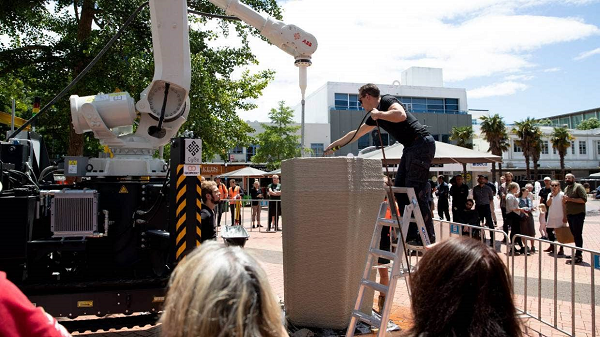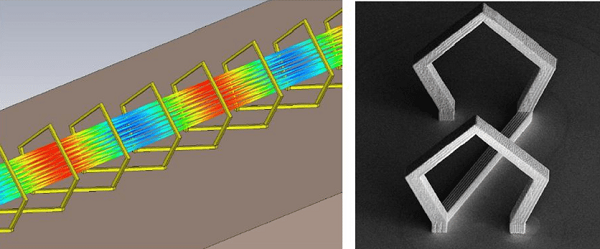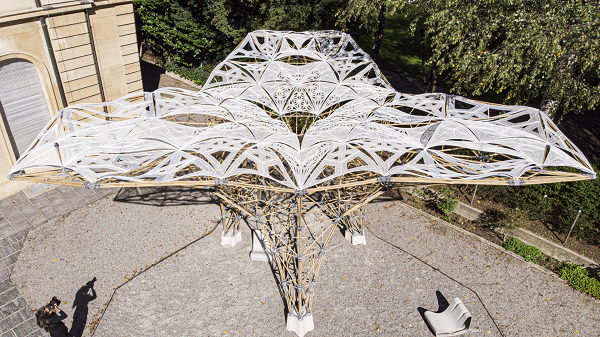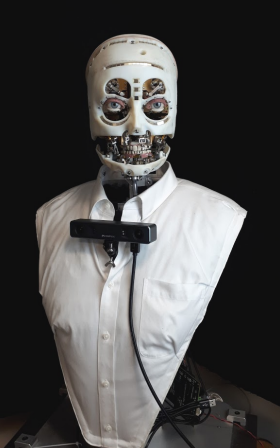3D Printing News Briefs, December 3, 2020: Continuous Composites, AIMS, ULTRAWAVE, Digital Building Technologies, QOROX, Disney
In this edition of 3D Printing News Briefs, Continuous Composites has opened a new manufacturing facility, while Kickstarter device AIMS was designed to fully automate 3D printing with an AI assistant and camera. The ULTRAWAVE Project is working on 3D printing for 5G networks, Digital Building Technologies 3D printed bespoke connections for a bamboo pavilion, and Kiwi company QOROX is hoping its 3D printed park bench could eventually lead to 3D printed housing. Finally, Disney Research developed a system that can give robots an extremely lifelike gaze.
Continuous Composites Showcases CF3D Technology at New Facility
At the virtual Formnext Connect 2020, Idaho-based Continuous Composites unveiled its newly launched facility for R&D and additive manufacturing, which will serve to showcase its patented Continuous Fiber 3D Printing (CF3D®) technology at a build volume 25 times larger than before. The company has been steadily building partnerships with other AM leaders in order to commercialize its technology, and several of these partners helped with the launch of the new demonstration facility, so all can develop real customer applications for CF3D. The solution is empowered by Siemens‘ Sinumerik 840D CNC system and RunMyRobot/Direct Control platform, and Güdel scales the technology with its TrackMotion Floor 50-foot linear rail. Comau leverages its six-axis robotic arm for CF3D, and finally, Arkema, through its Sartomer materials business, has been working to build a library of its N3xtDimension thermosetting resins for the technology.
“These partnerships were mutually selected, us choosing them and them choosing us, knowing that by joining efforts, CF3D technology will rapidly scale to the next phase of its capabilities. Our new facility allows us essential access to research and development that is completely in stride with a powerhouse team of strategic partners and customers,” said Tyler Alvarado, Continuous Composites CEO.
AIMS Device on Kickstarter for Automated 3D Printing
A new Kickstarter campaign is aimed at the total automation of 3D printing through the use of a handy device called AIMS, or Autonomous Intelligent Management System. The small smart box provides an offline artificial intelligence (AI) assistant and camera, offering several functions for monitoring your print jobs and letting you know quickly if there’s a problem. AIMS, which is said to be easy to install, uses Nanonet, a pre-trained neural network, to detect many common print failures, such as running out of filament, stringing filament, or the print head catching on the model. A camera can also be moved up and down in order to give users the best angle and view of the print bed.
“AIMS has been trained to recognize unusual movement, and stringing that isn’t consistent with standard prints. It also tracks the print head, making sure there’s no unexpected skips or the print head doesn’t get stuck, that there’s no large open space between the print head and printed part. You must power on AIMS before starting a print, so that it can establish a background and baseline for detection,” the AIMS campaign states.
Early bird pledges are still available for £73, which is a 10% discount off the retail price. If the AIMS campaign is successful by its end date of December 31st, 2020, shipping is expected to occur in April of 2021.
ULTRAWAVE: 3D Printing for 5G Networks
When a global 5G network became necessary in 2017 in order to strengthen the cellular network infrastructure, the Ultrawave project was launched as part of the EU’s Horizon 2020 initiative. Wavelengths needed to be shorter to carry more data at a higher frequency; for example, 5G applications often use frequencies that are between 30-300 GHz, which feature wavelengths between 1-10 mm. These “mmWaves” are essential to a network transmitting high data applications, and so Ultrawave wanted to attain 100 gigabits of data per second by exploiting this wavelength spectrum. Unfortunately, attenuation happens more often to these smaller wavelengths, so the project had to figure out how to strengthen the signal, and landed on mmWave Traveling Wave Tubes (TWT), which are coil structures that strengthen radio frequency signals.
Goethe-Universität Berlin researchers completed finite element modeling analysis of different waveguide shapes, and how they influenced signal strength. They learned that without a microscale guide, the waves lose amplitude, which is why the university team asked Exaddon to 3D print waveguides that could be used within TWTs. Exaddon jumped on board, and used its unique CERES µAM printing system to create tiny, pure copper waveguides measuring at just 120 µm in diameter. These microscale 3D printed waveguides are an important step in implementing the Ultrawave project and innovating high frequency technology.
3D Printed Connectors Hold Digital Bamboo Pavilion Together
Architecture and Digital Fabrication masters students at ETH Zurich designed a really interesting structure, based on research by Digital Building Technologies. The Digital Bamboo pavilion extends nearly five meters in three directions through the use of cantilevers. Custom computational tools were used to create the form-found geometry of the ultra-lightweight pavilion, which is made up of over 900 sustainable bamboo elements, and a spatial truss reinforced by post-tensioned cables is at the center of the structure’s main load-bearing system. A hybrid strategy of Direct Metal Laser Sintering (DMLS) and MultiJet Fusion 3D printing solutions was used to print 380 intricate, bespoke connections that hold all the bamboo elements together, and the technology was able to achieve assembly tolerances and minimal volume for the connectors. 3D printing was also used to fabricate the pavilion’s shading panels out of a UV-resistant, recyclable thermoplastic onto a lycra textile, and the pre-assembled parts of the Digital Bamboo Pavilion were mounted on-site in just two days.
“The construction system developed for the Digital Bamboo pavilion aims to reduce the logistic efforts of construction while exploiting the advantages of digital fabrication for a more sustainable building culture. Following the principle of distributed prefabrication, the complexity of the structure is encapsulated in small parts that can be fabricated all over the world using 3D printing. These custom parts can be used to construct high-performance structures together with local materials,” Digital Building Technologies writes.
“Digital Bamboo offers a new paradigm for how digital fabrication can lead to a sustainable future in construction, combining locally sourced materials with 3d printed parts to achieve new immersive architectural expression.”
3D Printed Park Bench in New Zealand

A segment of a stylised concrete bench is printed during a public demonstration in Hamilton’s Garden Place.
QOROX, a New Zealand 3D printing company, was recruited by the city council of Hamilton to make a 3D printed stylized park bench. Using a robotic arm 3D printer purchased from CyBe Construction and quick-drying concrete, the team got to work, showcasing the technology in some recent public demonstrations. Once it’s finished, the 3D printed bench will stay in Garden Place until early 2021, before it’s moved to Hayes Paddock as part of a playground upgrade. But the real story here is the potential that construction 3D printing has for helping solve the housing crisis in the country, which has been slow to catch on to this trend. Architectural engineer Wafaey Swelim, the QOROX director, says that the CyBe robot printer can fabricate the walls of a house in just a week, and can 3D print on-site or off if needed. 3D printed houses will still use conventional building elements for parts like the roof, and the walls need to be reinforced in order to comply with New Zealand Building Code, but Swelim says that both the Hamilton City Council and Auckland Council are “receptive” to the idea.
“The future in construction is in automation, it’s not trying to do the same thing over and over again. Unfortunately, the automation [in New Zealand] stops in the manufacturing process and it has not crossed over to construction sites,” Swelim said.
“The only way for us to evolve quickly and have a decent footprint in the [construction] market is if we share the knowledge rather than working in silos.”
Research on the Realistic, Interactive Robot Gaze
A team of researchers from Disney Research, the California Institute of Technology, the University of Illinois at Urbana-Champaign, and Walt Disney Imagineering published a paper about their work developing a system to achieve a realistic, interactive gaze for robots in interactions with humans. Using the humanoid Audio-Animatronics bust in the image above, which is controlled with a custom proprietary software stack and will haunt my nightmares, the team created a general architecture to help create lifelike gaze interactions both from a technological point, as well as character animation, where, as they write, “the fidelity and believability of motion is paramount.” A stationary Mynt Eye D-1000 RGB-D camera mounted to the robot’s upper torso allows it to “perceive” people in its field of view (FOV), and a perception engine then fits the person’s skeleton in 2D, before depth-projecting to offer 3D joint locations. An attention engine uses the 3D positions of people in the robot’s FOV to assign a numerical value to each skeleton in order to differentiate between the people, which allows the robot to estimate what actions the people are performing and then determine what gaze behavior it should adopt.
“A complete system is described that perceives persons in the environment, identifies persons-of-interest based on salient actions, selects an appropriate gaze behavior, and executes high fidelity motions to respond to the stimuli. We use mechanisms that mimic motor and attention behaviors analogous to those observed in biological systems including attention habituation, saccades, and differences in motion bandwidth for actuators. Additionally, a subsumption architecture allows layering of simple motor movements to create increasingly complex behaviors which are able to interactively and realistically react to salient stimuli in the environment through subsuming lower levels of behavior. The result of this system is an interactive human-robot experience capable of human-like gaze behaviors,” they wrote.
Subscribe to Our Email Newsletter
Stay up-to-date on all the latest news from the 3D printing industry and receive information and offers from third party vendors.
You May Also Like
Gorilla Sports GE’s First 3D Printed Titanium Cast
How do you help a gorilla with a broken arm? Sounds like the start of a bad joke a zookeeper might tell, but it’s an actual dilemma recently faced by...
Nylon 3D Printed Parts Made More Functional with Coatings & Colors
Parts 3D printed from polyamide (PA, Nylon) 12 using powder bed fusion (PBF) are a mainstay in the additive manufacturing (AM) industry. While post-finishing processes have improved the porosity of...
$25M to Back Sintavia’s Largest Expansion of Metal 3D Printing Capacity Since 2019
Sintavia, the digital manufacturing company specializing in mission-critical parts for strategic sectors, announced a $25 million investment to increase its production capacity, the largest expansion to its operations since 2019....
Velo3D Initiates Public Offering in a Bid to Strengthen Financial Foundations and Drive Future Growth
Velo3D (NYSE: VLD) has been among a number of publicly traded 3D printing firms that have attempted to weather the current macroeconomic climate. After posting a challenging financial report for 2023,...




































